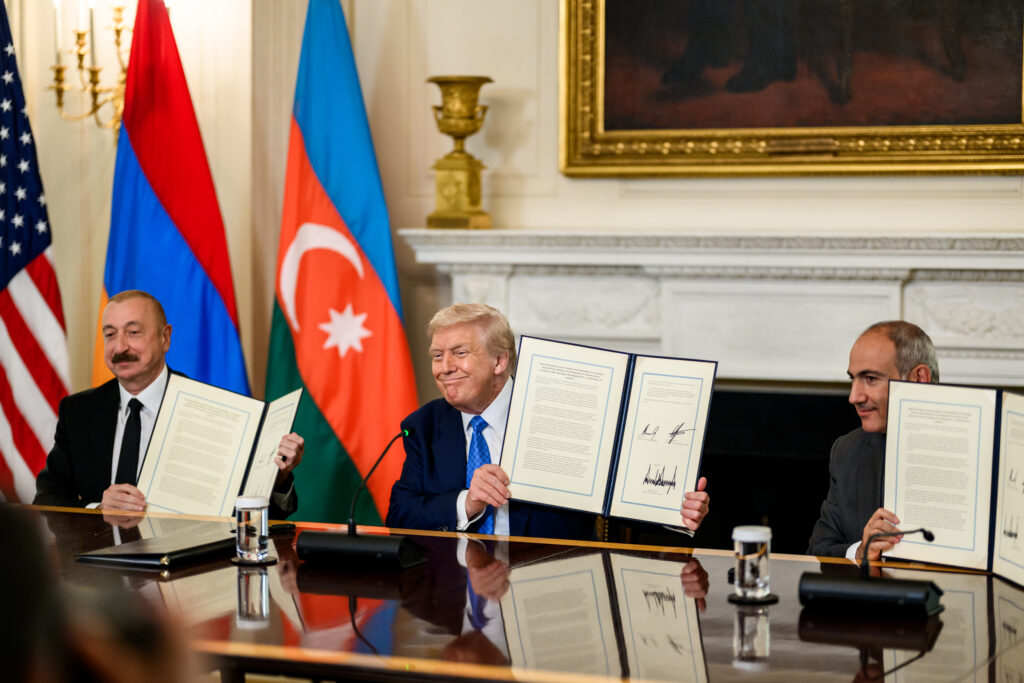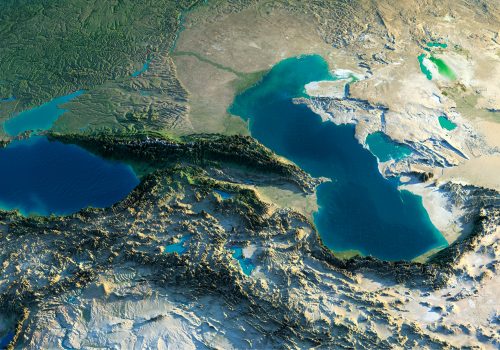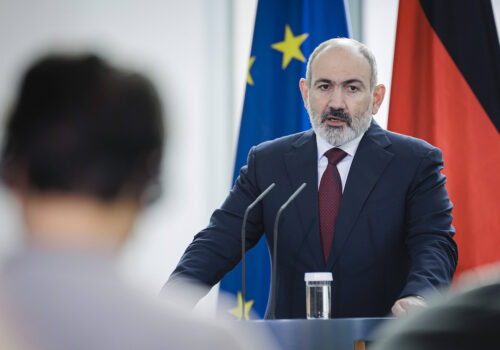The joint peace declaration signed at the White House on August 8 by Azerbaijani President Ilham Aliyev and Armenian Prime Minister Nikol Pashinyan is a major step toward advancing stability, peace, and prosperity in the Caucasus and Central Asia. US involvement played a major role leading up to the signing, and Washington’s continued involvement will be necessary for the successful ratification and implementation of the agreement.
There are also important geopolitical implications. The meeting and declaration sent needed signals to Russia, Iran, and other regional players. The United States is now in a position to play a critical role in the South Caucasus to help develop the region economically, oversee the proposed transit corridor, and to counter any malign third-party influence in the region.
Importantly, Turkey can now serve as a buffer and deterrent against any unhelpful interference in the region. The events of this past week demonstrate a policy shift that we had pushed for during our time serving as US ambassadors to Azerbaijan—no longer treating the Azerbaijan-Armenia conflict as an issue that can only be managed, but one that can be resolved.
The joint declaration, however, is not a final peace agreement. It does not in itself completely end the conflict that turned into open warfare between the two former Soviet republics during the final days of the Soviet Union. The Washington joint declaration’s first paragraph, however, notes that US President Donald Trump and the Armenian and Azerbaijani leaders “witnessed the initialing of . . . the agreement on establishment of peace and inter-state relations” between the two countries and acknowledges the need “for further actions to achieve the signing and ultimate ratification of the agreement, and emphasized the importance of maintaining and strengthening peace between our two countries.” The declaration contains many positive and constructive provisions, which, if successfully implemented, will create a lasting peace in the region. The United States must continue to play a major role in insuring that all necessary steps are taken.
The Washington meeting also envisioned another step to help realize the long-overdue peace: the need to enable road, rail, and possibly oil and gas pipeline connections across Armenia’s Syunik region in the country’s south to link mainland Azerbaijan with its Nakhichevan exclave. The declaration “reaffirm[s] the importance of the opening of communications between the two countries . . . on the basis of respect for the sovereignty, territorial integrity, and jurisdiction of the states.” It continues: “These efforts must include unimpeded connectivity between the main part of the Republic of Azerbaijan and its Nakhichevan Autonomous Republic through the territory of the Republic of Armenia with reciprocal benefits for international and intra-state connectivity for the Republic of Armenia.”
The declaration then goes on to say that:
- Armenia will work with the United States of America and mutually determined third parties, to set forth a framework for the “Trump Route for International Peace and Prosperity” (TRIPP) connectivity project in the territory of the Republic of Armenia. We confirm our determination to pursue efforts in good faith to achieve this goal in the most expeditious manner.
This provision highlights a key factor: For the declaration to work and to have the peacebuilding result the administration wants, Washington must stay committed and remain actively and visibly engaged. The declaration reportedly envisions private-sector US engagement in building and maintaining new roads across the twenty-seven-mile stretch of Armenia’s Syunik province as well as a new, modern rail link, and possibly new oil and natural gas pipelines. The idea is that these links will connect not just the territory of Azerbaijan and Armenia, but also form links connecting Turkey and the rest of Europe with Central Asia and perhaps China and South Asia as well.
But wishes and verbal declarations are not enough. Next, the White House should instruct, empower, and deploy officials from the State Department, the Commerce Department, the Development Finance Corporation, the Trade Development Agency, and probably others to work with the Armenian and Azerbaijani governments, companies in those countries, and US firms. Only with this kind of concerted engagement can the United States help make these transit communications, and the peace, security, and prosperity benefits they can bring, a reality.
Moreover, the State Department and other agencies should engage Turkey, Georgia, and the Central Asian states to ensure the new transport links realize their full commercial and geopolitical potential, including as a counter to China’s regional ambitions. Both of us know well the work that we, our embassies, and the relevant offices in Washington did together to realize energy pipelines in the South Caucasus following the Soviet Union’s collapse. That work can be a model for this new chapter for the region.
Likewise, the United States should help Armenians and Azerbaijanis take other necessary steps to realize a real, lasting peace. This work should include actively engaging Azerbaijanis and Armenians to build personnel connections and promote understanding after nearly four decades of hostility. Again, the US government has in the past created and implemented programs throughout the world that successfully fought preconceptions, fostered better understanding among former enemies, and built lasting peace. The United States can—and must—do so again.
It must be acknowledged, however, that many of the experts who worked on such initiatives have been terminated and that much expertise was lost by recent cuts at the State Department, the US Agency for International Development, and elsewhere. It may still be possible to recall and deploy some of these experts to pursue the White House’s objectives in the region. Moreover, there are nongovernmental organizations, universities, and think tanks with proven records of success on the peacebuilding front that could contribute to these efforts as well.
The August 8 meetings and declaration were noteworthy and much-needed steps toward a lasting peace between Armenia and Azerbaijan. But as necessary and praiseworthy as these steps were, history will judge them by what happens next. More needs to be done to bring lasting peace, stability, and prosperity to the region, and continued active US engagement is essential to successfully achieve this vision.
Robert F. Cekuta is a former US ambassador to Azerbaijan and former principal deputy assistant secretary for energy.
Richard L. Morningstar is the founding chairman of the Global Energy Center and a board director at the Atlantic Council. He served as the US ambassador to the Republic of Azerbaijan from July 2012 to August 2014.
Further reading
Mon, Jun 9, 2025
Armenia’s ‘crossroads’ offers the US and Israel a rare opportunity
MENASource By
Clinching peace between Armenia and Azerbaijan offers the US and Israel a rare chance to tilt the balance of power in the South Caucuses.
Wed, May 7, 2025
Time to adjust the US approach to the South Caucasus
TURKEYSource By
To foster stability, enhance connectivity, and promote long-term strategic balance in the South Caucasus, the United States must reassess its posture in the region.
Wed, Feb 5, 2025
Armenian Prime Minister Nikol Pashinyan outlines his vision for peace in the region
New Atlanticist By Katherine Golden
“It isn’t possible to have real and thriving independence, prosperity, and security without peace,” Pashinyan argued at an Atlantic Council event.
Image: Azerbaijan President Ilham Aliyev, left, and Armenia Nikol Pashinyan sign peace agreement in front of US President Donald Trump aimed at ending decades of conflict at the White House on Friday Aug 8, 2025. Azerbaijan and Armenia fought over Nagorno-Karabakh, an ethnically Armenian enclave in Azerbaijan, in the 1980s and 1990s and violence has flared up in the years since. White House handout via Reuters Connect.




